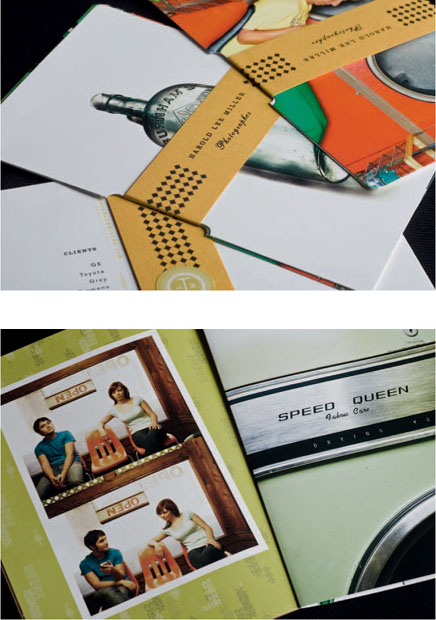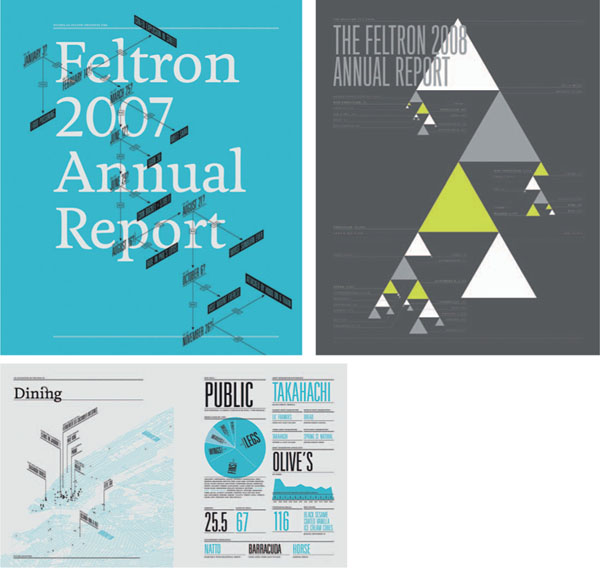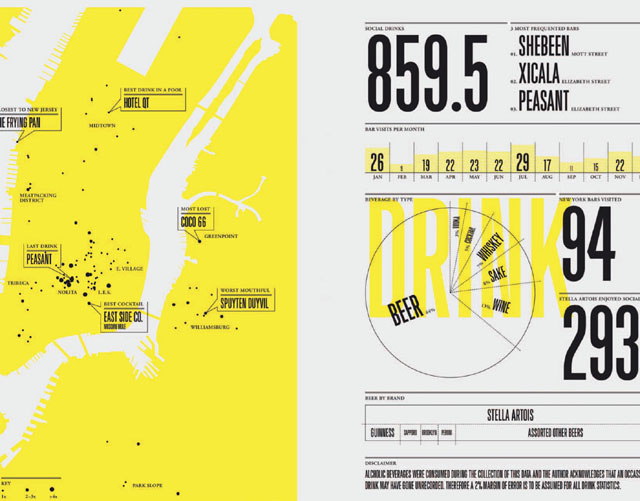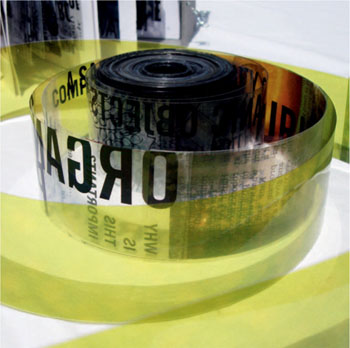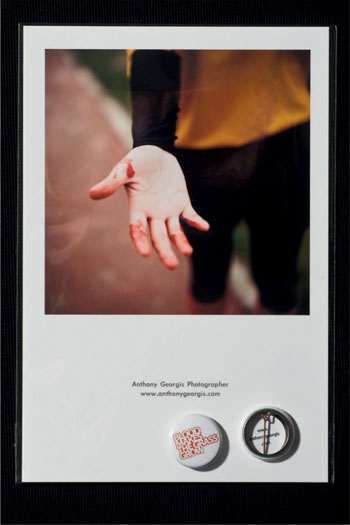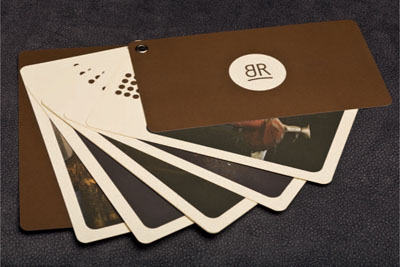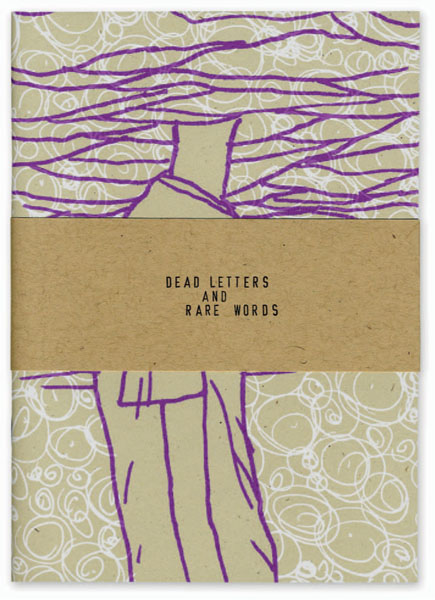STEP SEVEN
PROMOTIONAL
MATERIALS
PROMOTIONAL MATERIALS
Introduction
Aside from, and in addition to a portfolio, many people create promotional materials in order to market their talents and abilities. Unlike a portfolio, promotional pieces do not typically represent an artist's range or depth within an industry, but are instead focused around one central idea, providing a “snapshot” of one's capabilities. Promotionals are a great way to grab someone's attention and pique his or her interest—enough so that a potential client or employer would hopefully want to know more. That's difficult to do though, as most creatives in the industry have just about seen it all.
For that reason, the most successful promotional pieces are often developed around a specific and entertaining concept, form, or central theme, making them stand out and be more memorable. They should also accurately reflect the kind of work you want to do. Such a project can be developed as a single work or as a series of interrelated pieces. Often promotionals are developed in such a way that they can be made quick and cheap, easy to recreate and distribute. However, promotional pieces should still be a reflection of exquisite craftsmanship and attention to detail, reflecting the care and pride you take in your work.
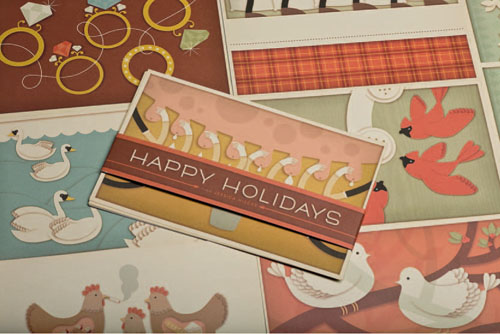
JESSICA HISCHE, STUDENT PROMOTIONAL, Tyler School of Art.
Promotional pieces can be made to:
1. Function on their own, in absence of, or in addition to a portfolio.
2. Created in order to specifically drive someone to a portfolio, particularly an online one. Such promotionals are often designed in a similar style or conceptual framework as the portfolio itself, establishing a visual link and brand connection.
Promotional materials can take many forms, such as books, postcards, stickers, 3D objects, buttons, videos, animations, and more.
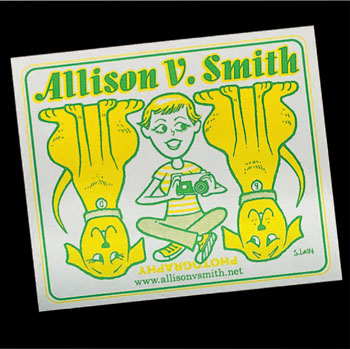
ALLISON SMITH, PROMOTIONAL MATERIALS, Dallas, TX.
Professional Organizations and Networks
While it goes without saying that relationships in your professional community are essential, they can also be extremely useful in extending yourself, your services, and your product, and for some, your brand. ASMP (American Society of Media Photographers), PPA (Professional Photographers of America), and AIGA (the professional organization for designers) are three examples of large organizations that provide resources both nationally and regionally. In addition to keeping up on emerging issues such as copyright and pricing, meeting individuals in the working community eventually can pay off in terms of marketing. While they are often your peers who are competing for similar clients, general networking can provide leads and ideas for self-promotion. At minimum, feedback and sharing experiences with other creatives is always of value. Finally, your membership to a professional association can add to your credibility as an invested professional who is established, or working toward establishing a long-term career.
Organizations and publications of your particular client's industry can also be useful for tracking trends, and identifying potential clients. It is also possible to access industry or association databases (if you are a member) to identify potential clients to target.
Mailings: Electronic versus Hard Copy
While electronic postcards or image samples are cost effective and easy to employ, they are not necessarily a replacement for printed mailers for the very same reason's that printed mailers are not an end themselves either. Your email, while effective, has less chance of standing out if viewed via a subject line that looks like every other email subject line and is part of hundreds of emails an individual might receive in a day. Essentially, you have no control over the delivery.
Further, if a potential client does open your email to view it, if it doesn't get printed out, it becomes one of dozens that are in their inbox at the end of the day. A busy editor or art buyer may not have the time or inclination to sort through emails to find you again. Electronic forms can be supplements to initial contacts, particularly when you are known to the individuals to whom you are sending materials.
A hardcopy printed postcard or mailer can be easily filed and saved for reference at a later date. While it is true that dozens may come into the office of a potential client, if you have done your homework, you have a better chance of being seen.
If your goal is to be hung on the wall the image should be something I'd be proud to display in front of all my colleagues. If your goal is a website visit it should be something intriguing that makes me want to see what the hell you're all about. If your goal is for me to show it to someone else it should be impressive, outrageous or hilarious. If your goal is a phone call then you need a bit of perfect timing so that the card lands on my desk when I'm looking for someone like you.1
– ROB HAGGART, A Photo Editor
HAROLD LEE MILLER, PROMOTIONAL MATERIALS, Indianapolis, IN.
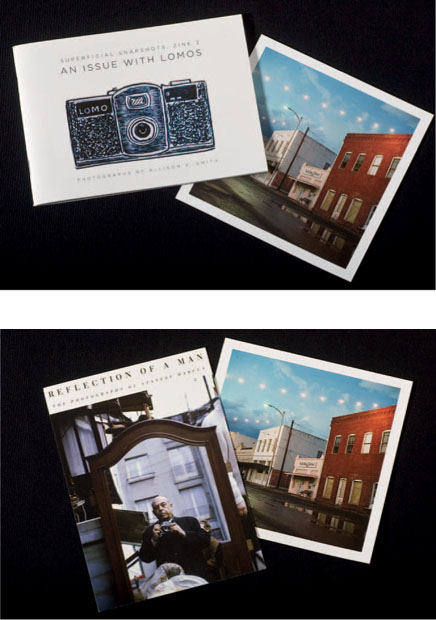
ALLISON SMITH, PROMOTIONAL MATERIALS, Dallas, TX.
NICHOLAS FELTON, PROMOTIONAL MATERIALS, New York, NY.
Check out these personal promotional booklets from New York designer Nicholas Felton. He takes facts about his own life and turns them into a veritable feast of information design. He has published three such “annual reports” to date, aptly named the Felton Reports. His website, http://www.daytum.com, allows users to create their own personalized reports.
ALISON MURPHY, STUDENT PROMOTIONAL, Massachusetts College of Art & Design.
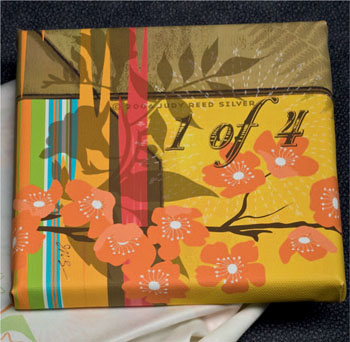
JUDY REED-SILVER, PROMOTIONAL MATERIALS, Calabasas, CA.
Marketing Tactics for Photographers
What is the best way to use mailers/portfolios and websites, and how do you send out something that isn't going to get instantly tossed in the trash? There are always more photographers available in any given week than there are jobs to be photographed. This doesn't mean that a creative director or buyer isn't interested in hiring you for your particular talent. He or she just might not have the job that fits your vision. Often your mailers, if they get the attention of someone, will be held or filed for future reference. You should think toward the longer term. Frequently, it may take a while for a client to find an appropriate job for someone they have not worked with. You may end up on file for more than a year. During that time, you need to show that you are out there and still working and still in the mix. You should be sending materials on a regular basis.
Have a Plan
To effectively reach your target audience or market you must have all of your materials ready and in good order. This means your website is live and accessible and your portfolio up to date and ready to ship. Once you start your initial marketing you want to be prepared to continue to make contact and send out materials. Never contact anyone if you aren't ready to send out your portfolio. It is often best to think three steps ahead. In addition, you would be well served by having your calendar worked out and determine how many pieces you are going to send during the year. Often the most difficult thing to maintain when work and contracts come in is self-promotion. If you need to have mailers printed, or you are putting together a particular promo for a specific group of clients, it is easier to get them produced and printed at the same time to be sent out at a later date.
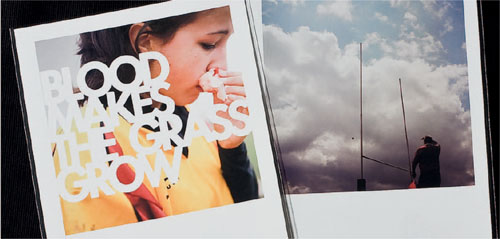
ANTHONY GEORGIS, BLOOD MAKES THE GRASS GROW, PROMOTIONAL BOOK.
Competitions as Marketing Tools
Your portfolio and related promotional materials are the basis for this book, but the bottom line is that you must create visibility for yourself in a number of different ways. While contests in some sense can be validating and are good resume builders, more significantly they offer great bang for the buck as targeted marketing tools. These contests are resources for professionals seeking new talent. Inclusion in a contest or annual is an extremely valuable way for you to distinguish yourself in an oversaturated market. There are numerous industry-specific contests and annuals that are from publications and organizations such as Graphis, How Magazine, Communication Arts, PDN, SPD, Adobe Achievement Awards, The Type Directors Club, AIGA, AAF-ADDY Awards, London International Awards, etc. (see Appendix A for more).
Contests and juries create visibility, and further, they create credibility by having your work vetted by jurors who frequently are known industry professionals. Having your work selected can raise your profile in the eyes of potential clients, and they are extremely valuable in extending your work and your visual identity.
Marketing Tactics for Designers
Since most designers are looking to secure a full-time salary position and not a contract or freelance job, the designer's approach to marketing may be a little different than that of most photographers. A salary position often represents a significant commitment on the part of an agency or creative shop, more so than just a single job. It's a fairly serious investment on their part, especially considering benefits and the dedication of space and computer resources. Because of this, your promotional materials need to communicate a sense of who you—your attitudes and personality and what it would be like to work with you on a day-to-day basis. They also need to entice someone into wanting to know more and driving them toward your portfolio.
For designers, target specific companies or areas of the design discipline with promotional pieces that will resonate with a particular kind of company or client. Make pieces that are about more than just the “wow factor.” Make work that is thoughtful, relevant, and will engage someone on an intellectual and emotional level—big ideas that are well executed will win people over. Highlight your amazing expertise or talent in a particular area. Think about unique approaches, forms, and concepts that will entertain and make a memorable impact.
Marketing and Self-Promotion: What to Do, and Connecting to Your Targeted Audience
Photographers and designers have more options for marketing that go far beyond the traditional practice of direct mail and cold calling. Online portfolios in combination with various materials can enable you to contact and update your targeted audience creatively and with great variety.
For Jeanie Chong's senior project she created her own unique typeface, inspired by five African tribal pictographs. She designed and developed a number of promotional materials featuring it, including a multipage newspaper.

JEANIE CHONG, STUDENT PROMOTIONAL, Otis College of Art and Design.
While it is now considered essential for any photographer creative to have an online portfolio, the very fact that it is live and accessible does not guarantee you will be seen. The key is to take full advantage of the resources available to you and to think broadly regarding the approaches to reaching your target audience and breaking through. While electronic methods are convenient and cost effective, they do not eliminate the need to be innovative in what you send. Do not simply rely on the convenience of mass mailings, electronic, or otherwise.
Tip: Common sense—do your homework. While it may seem obvious, indiscriminate marketing, particularly email blasts, are not the most efficient or effective way to get on someone's radar. Sure, electronic systems make it easy and inexpensive to send out hundreds of emails, but you would do better to research to whom you are sending promotional pieces and what you should be sending them. Beyond the type of image you are sending out, you should consider the quality, level of production, and content. That doesn't mean you should rule out showing some range, but if you are so far off the mark, you may be wasting your time and might close out further opportunities with a particular individual, because they will have ruled out your work in relation to their needs.
Resources for Finding Your Audience
When working on direct mailings, electronic mailings, or sending out packages to targeted clients, it is important to have up-to-date information regarding art buyers, editors, creative directors, and designers. There are numerous services available that provide access to information regarding the individuals who you wish to target. Most of these services have subscription-based fee structures. For someone just entering the market, these costs can seem prohibitive, but in the long run they can save a great deal of time and energy when looking to build a client base. These databases are updated regularly and provide specific information and contacts. Two of the largest are Adbase and Agency Access.
An additional advantage of services such as Adbase is that one is able to download contacts and addresses that have been formatted for labels or email, which saves labor and time putting together mailings.
What Happens When It Works?
Self-promotion is an ongoing process or, better put, a never-ending process. Once you get someone's attention, submitted a portfolio, or even been hired, the communication has just begun. In fact, it is even more important to continue to stay in contact and keep past and potential clients aware of your presence and your work. You need to stay on their radar. What do you do once you have established contact, perhaps even had your portfolio requested by a buyer or editor? Follow-up and continued contacts are very important.
If an art buyer, potential employer, or editor makes an initial contact with you and requests and views your portfolio, common courtesy is a good starting point. Follow up with a visual thank you or leave-behind. Then in the weeks and, more likely, months that follow, it is necessary to send mailers and updates on your work, commissions, and new ideas, to keep you in their sites. If you make significant updates to your website, information should be sent out. If you update your portfolio, request to send it out again to give the client a fresh view.
HOLLY BOBULU, STUDENT PROMOTIONAL BOOK, Madison Area Technical College.
JEFF ROSS, PROMOTIONAL, Chicago, IL.

AISLING MULLEN, STUDENT PROMOTIONAL, Endicott College.
Your Other Work?
Think broadly about what you use for self-promotion. It isn't necessary or advantageous to simply send materials that only reflect the particular kind of work your clients might hire you for. In fact, personal projects and work that show diversity of interests and some range as a creative can be much more effective in gaining the interest of a potential client or employer. If you are exhibiting, or are involved in collaborative works, you can consider using these for self-promotion. This kind of work demonstrates breadth in thinking and concept development, and presents your clients with other aspects of your abilities to consider when hiring you. While you don't necessarily want to appear as all things to all people, as this can give an unclear message as to what you are as a creative, you can show depth and range and use it to your advantage.
Get Listed
While the fact is that direct contact and showing your work is ultimately going to connect you to potential clients, you still can benefit from professional listings. PDN's Photoserve is a searchable listing for photographers. While it isn't likely that a busy photo editor or art buyer will have time to search for a photographer, these listings can be useful by demonstrating you are active and working and engaged in the profession. Professional associations such as ASMP have membership listings and periodically these can result in referrals. There are still paid listings and publications such as the The Black Book, but they represent a significant investment.
Some great websites for designers to get listed include Communication Arts (http://www.creativehotlist.com) and AIGA's “jobs and community” at http://www.aiga.org. Both allow you to post examples of your work and are searchable by field and location.
Showings and Exhibitions
While exhibitions of noncommissioned work, personal projects, or inclusion in juries may not appear to be relevant to your client's needs, they can be sent in addition to your other mailings and promos. They are another way to show your range and commitment to your work, as well as how active you are as a creative. These are better suited for clients with whom you have had prior contact or for whom you have worked. Your client may even have another kind of job for you as a result of seeing another aspect of your creative production.
Note about Photographer Representatives (Reps)
These individuals function essentially as agents, taking your work out for you and connecting you to potential clients. There is a range of representation for photographers, in terms of fee structures, yet the fundamental basis for this is that the photographer has to have established himself or herself in the market prior to an association with a representative. While representatives or agents vary in how they work with photographers, most often it is a collaborative process. With this in mind, the photographer will continue to be responsible for marketing, portfolios, personal work, contests, and the like. Generally, a representative will help you move into a better market and push your work and portfolio in the direction of art directors and buyers who you might not have regular access to. They also can take on the challenging aspects of bidding and pricing larger-scale projects.
I LOVE SEEING
PERSONAL WORK.
It shows me that the photographer has some excitement about story-telling and image making in general.
HEATHER MORTON
Independent Art Buyer
Q&A: Interview with Heather Morton, Independent Art Buyer
Heather Morton is a freelance art buyer working in Canada. She has been given the opportunity to introduce this role to some of the most interesting agencies in the country, including John St., Leo Burnett, and Zig. In addition to art buying, she offers portfolio review and consultation, rebranding services, and quoting assistance.
How important is a printed portfolio? Is a portfolio still a necessity in addition to online portfolios, and is it the case when looking at photographers that you will always request a printed portfolio at some point in the process?
Although I don't call in portfolios as much in the reviewing process as I used to (but rather look at the work online), I still think having a printed portfolio is important. Although art buyers are looking at work initially online, the portfolio shows a different side of the photographer. More than a photographer's website, it shows us how the photographer markets him/herself, what their branding is, how he edits his own work, his design sense—but I do think the portfolio functions best as a calling card. Getting your portfolio in the door is basically getting your brand in the door.
What makes for a good portfolio? Should it have an overall vision, concept, or a visual identity beyond an edit or series of strong images? How much work do you like to see?
I think less is more when it comes to number of images. For some photographers it is completely appropriate to their work that their book has a strong concept. I definitely like to see an overall vision—whether the book is subdivided into different sections which flow well into each other or it tells a cohesive story, I like to see a lot of thought put into the edit. Working with image juxtaposition, cropping, white space, the gutter, overall flow—have all of these things been taken into consideration?
My pet peeves:
- No Plastic sleeves: Enough said.
- Too many images: I think it's important to ask what the fifth portrait of a dower-looking 20-something in studio is telling me about your abilities—it's redundant at that point.
- One-off shots: Sometimes I see an interesting creative idea, but it's a one-off and relates to nothing else in the book. Normally, this just ends up looking out of place. In most cases, the idea could be developed into a larger series or a bigger story, even by grabbing detail shots to use as a juxtaposition to the hero shot.
- Ads in the main part of the book: Unless the ad is something fantastic (and there are some), I want to see the photography alone. I do, however, like to see a spread of thumbnail ads or tearsheets at the back of the book. This can be really useful to communicate the breadth of jobs the photographer has done.
To what extent is seeing work beyond commercial commissions or jobs (such as personal work) effective when you have looked at the portfolios of photographers?
I love seeing personal work. It shows me that the photographer has some excitement about storytelling and image making in general. It is a great way for me to get a sense for the photographer's style and passions. Personal work can also be inspiring for art directors to see—it might open up some avenues as they conceptualize ideas for their clients.
There is a mantra that I espouse which pertains to this question: Show what you want to shoot, not what you can shoot. This is the type of work that will get the creatives excited about working with you and finding a project for your unique vision.
Having said this, it is sometimes necessary to show the client, or even the art director, that the photographer has shot for this type of client before, or has shot this type of job before.
Creative Placement Agencies and Reps for Designers
If you're having a difficult time getting connected and finding employment, hooking up with a creative placement agency, creative rep, or creative recruiter can be beneficial. They work to match creative talent with companies in their network. This can be true for short-term freelance work and full-time salary positions. Often, placement agencies are even aware of positions that are not being advertised publicly and can open up a number of possibilities for you. Occasionally, placement agencies organize events, such as resume workshops, “meet and greets,” or interview fairs. They work with a person to secure a position and often offer advice about your portfolio, resume, interviewing style, etc. If you do find employment through a placement agency, they will work with you and the client to negotiate salary, benefits, and contract concerns. Make sure you are aware upfront how the agency or rep is being paid—typically the client pays for the service. Check out local agencies and reps first—they are often better connected with the local creative shops and talent.
Q&A: Interview with Kim Wachter, Senior Staffing Consultant, Hollister, Inc.
Kim Wachter is a senior staffing consultant for Hollister, Inc. in Boston. After 28 years in advertising and marketing working for companies like American Express, Scudder Stevens, and Clark, Rapp Collins, and Jack Morton, Ms. Wachter decided that a career change was in order. Currently, she handles any creative service or marketing position.
How important do you feel a print and/or online portfolio is in securing a job in the industry?
Both an online portfolio and a print portfolio are extremely important for both writers as well as designers (or ADs). We are inundated with resume submittals. Frequently I skip the resume and go right to the work. If a resume is not accompanied by a URL or at least PDF samples it gets moved down to the bottom of the email pile. Additionally, a print portfolio is important. We interview every candidate before I send them to clients, and I want to see how they present. Will they be an asset to the client when presenting creative ideas/campaigns? Is their presentation well organized and thought out? Do they have a story to tell? All too often, a candidate comes in with a hip portfolio case only to start pulling out old dog-eared samples in no particular order. My feeling is, if they don't take pride in their work, why should anyone else?
What do you think makes for an outstanding portfolio?
This is tough because each one is different and obviously writers need something different than designers and art directors. Regardless, the portfolio should grab me right away. I want to be enticed to continue to look through the samples. I want to forget that there's a pile of work on my desk and clients need to be called back. Also, the portfolio should reflect what the candidate does. So if the candidate is a UI designer, I want to see a clean elegant user interface on their own web page and also what technology they employed when designing their samples.
What qualities to you think a potential employer looks for in an applicant?
Obviously skill is important. However, in this market there are many skilled people. More and more employers are looking for the right chemistry. People are working harder now so they have to enjoy what they do. Also, employers are looking for candidates who can wear many hats. For example, we are getting more orders that call for hybrid design/development skills. Now, not only do they have to have a beautiful book, they have to be able to write code as well—front end as well as some back end.
What do you think makes for a successful interview?
A candidate should really do their research prior to going on an interview. LinkedIn is a great way to get to know the people you are interviewing with. Obviously, your recruiter should be able to prep you prior to an interview. A good recruiter gets to know their clients and will try to only send people who they think will click. A candidate shouldn't be afraid to ask things like “How do you think I'd fit in at company xyz?” or “How does my background fit your needs?” And of course don't be afraid to say “I'm really interested in this position. What are the next steps?”
Do you have any advice for a student currently working on his or her portfolio and/or promotional materials?
It's very hard for students because most companies are looking for some experience. Try to make sure you have as many real-world samples as possible. If all you have is school work, that's okay, but you should use things that look like they're real world. Fine art is great, but you probably won't be hired based on your lithographs. Also, many students have done internships with established companies and they put work in their portfolios that they have helped on. Please be aware that the art director or senior designer may also have that work in their portfolio and you don't want to misrepresent your work. It's perfectly permissible to annotate the work with something like “I did the Photoshop work on all photography.”
Q&A: Interview with Bryn Mooth, Editor, HOW Magazine
Bryn isn't a graphic designer, and only occasionally pretends to be one. Nonetheless, she's keen on classical typography, and she's a sucker for letterpress printing. Bryn's involvement with HOW magazine spans nearly 20 years, both as a staff editor and contributing writer. During that time, she has written about design and the business of design, organized and judged countless design competitions and spoken at various professional events, including HOW's Design Conference, In-HOWse and Mind Your Own Business Conference, and AIGA chapter events.
As someone who has reviewed so many outstanding portfolios and self-promotional pieces, what distinguishes the very best?
Originality and personality are so important for self-promo pieces and portfolios. As a potential client or employer, I'd want to get a sense not only of the designer's talents, but also of what it would be like to work with her. And it's key to be able to show your thinking. For portfolios, that means including sketches that led to a finished project. For self-promo pieces, that means including case studies of how your work met a client's objective. And of course, the overall design of the piece or portfolio should reflect the designer's personality, originality and thinking.
How important do you feel a portfolio book and/or online portfolio is in securing a job in the creative industries?
Both are crucial. Prospective employers or clients need to see samples of your work online before they even consider bringing you in for a meeting. And then a portfolio that showcases your work during that meeting is essential.
In the last few years, have you noticed any trends or differences in the types of pieces submitted to HOW's Promotion Design competition?
We're seeing more and more work that has a handmade element: perhaps a promo piece that's hand-bound, or customized for the recipient. Digital printing is, for the most part, so good that designers can print small-run pieces in their own studios. Handmade touches convey personality and uniqueness.
Do you have any advice for a student or young professional currently working on their portfolio and/or promotional materials?
What you say about your portfolio is just as important as what you put in it. Be prepared to walk a client or employer through one or two projects from start to finish, detailing your thinking, your problem-solving, your creative process and your collaborative skills. A portfolio is only a jumping-off point for conversation.
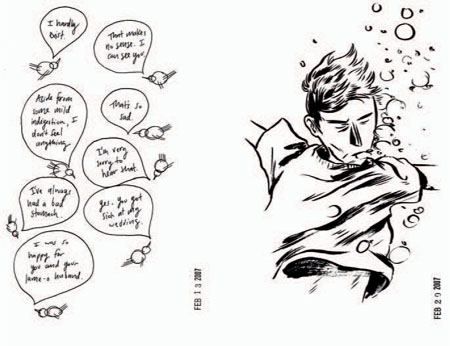
MARKBURIER, PROMOTIONAL BOOK, McLean, VA.
The book has a 2-color silkscreen cover and xeroxed insides. I used a printer for the cover and assembled it all myself. When doing small print runs, there's such a cost savings doing it that way.
–MARK BURRIER

